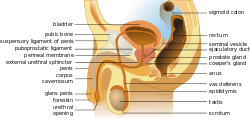- Male reproductive system (human)
-
This article is about the human male reproductive system. For the male reproductive systems of other organisms, see Sexual reproduction.
Male reproductive system (human) 
Drawing of the Male Internal Sexual Anatomy Latin systema genitale masculinum The human male reproductive system (or male genital system) consists of a number of sex organs that are a part of the human reproductive process. In this type of reproductive system, these sex organs are located outside the body, around the pelvic region.
The main anatomically male sex organs are the penis and the testes which produce semen and sperm, which as part of sexual intercourse fertilize an ovum in an anatomically female person's body and the fertilized ovum (zygote) gradually develops into a fetus, which is later born as a child[citation needed].
Contents
External genital organs
Penis
Main article: Human penisThe penis is the anatomically male copulatory organ. It has a long shaft and enlarged bulbous-shaped tip called the glans penis, which supports the foreskin. When the anatomically male person becomes sexually aroused, the penis becomes erect and ready for sexual activity. Erection occurs because sinuses within the erectile tissue of the penis become filled with blood. The arteries of the penis are dilated while the veins are passively compressed so that blood flows into the erectile cartilage under pressure.
Scrotum
Main article: ScrotumThe scrotum is a pouch-like structure that hangs behind the penis. It holds and protects the testes. It also contains numerous nerves and blood vessels. During times of lower temperatures, the muscle contracts and pulls the scrotum closer to the body, giving it a wrinkled appearance.The scrotum remains connected with the abdomen or pelvic cavity by the inguinal canal.(The spermatic cord, formed from spermatic artery,vein and nerve bound together with connective tissue passes into the testis through inguinal canal.)
Internal genital organs
Epididymis
Main article: EpididymusThe epididymis is a whitish mass of tightly coiled tubes cupped against the testicles. It acts as a maturation and storage place for sperm before they pass into the vas deferens, tubes that carry sperm to the ampullary gland and prostatic ducts.
Vas deferens
The vas deferens also known as the sperm duct is a thin tube approximately 17 inches long that starts from the epididymis to the pelvic cavity.
Testes
The testes, also known as the testicles, are the anatomically male gonads, the organs that produce sperm cells. The testes are egg-shaped structures that grow to be about one inch long and rest inside the scrotum. The testes also produces hormones, including testosterone, which stimulates the production of sperm cells and facilitates male maturation.
Accessory glands
Three accessory glands provide fluids that lubricate the duct system and nourish the sperm cells. They are the seminal vesicles, the prostate gland, and the bulbourethral glands (Cowper glands).
Seminal vesicles
Main article: Seminal vesicleSeminal vesicles are sac-like structures attached to the vas deferens at one side of the bladder. They produce a sticky, yellowish fluid that contains fructose. This fluid provides sperm cells energy and aids in their motility.
Prostate gland
The prostate gland surrounds the ejaculatory ducts at the base of the urethra, just below the bladder. The prostate gland is responsible for the production of semen, a liquid mixture of sperm cells, prostate fluid and seminal fluid.
Bulbourethral glands
The bulbourethral glands, also called Cowper glands, are two small glands located on the sides of the urethra just below the prostate gland. These glands produce a clear, slippery fluid that empties directly into the urethra. It produces substances related to nourishment of spermatozoa.
See also
References
Human systems and organs TA 2–4:
MSBone (Carpus · Collar bone (clavicle) · Thigh bone (femur) · Fibula · Humerus · Mandible · Metacarpus · Metatarsus · Ossicles · Patella · Phalanges · Radius · Skull (cranium) · Tarsus · Tibia · Ulna · Rib · Vertebra · Pelvis · Sternum) · CartilageTA 5–11:
splanchnic/
viscusmostly
Thoracicmostly
AbdominopelvicDigestive system+
adnexaMouth (Salivary gland, Tongue) · upper GI (Oropharynx, Laryngopharynx, Esophagus, Stomach) · lower GI (Small intestine, Appendix, Colon, Rectum, Anus) · accessory (Liver, Biliary tract, Pancreas)TA 12–16 Blood
(Non-TA)General anatomy: systems and organs, regional anatomy, planes and lines, superficial axial anatomy, superficial anatomy of limbsMale reproductive system (TA A09.3–4, TH H3.07.02, GA 11.1236) Internal layers (Tunica vaginalis, Tunica albuginea, Tunica vasculosa testis) · Appendix · Mediastinum · Lobules · Septa · Leydig cell · Sertoli cell · Blood-testis barrierOtherSeminiferous tubules (Tubuli seminiferi recti, Rete testis, Efferent ducts) · Epididymis (Appendix, Stereocilia) · Paradidymis · Spermatic cord · Vas deferens (Ampulla) · Ejaculatory ductAccessory
glandsExternal root (Crus, Bulb, Fundiform ligament, Suspensory ligament) · body (Corpus cavernosum, Corpus spongiosum) · glans (Foreskin, Frenulum, Corona) · fascia (superficial/subcutaneous, deep/Buck's) · Tunica albuginea · Septum of the penisCategories:- Male reproductive system
Wikimedia Foundation. 2010.
